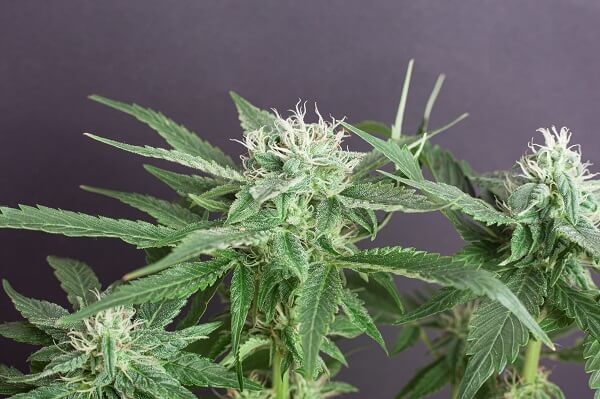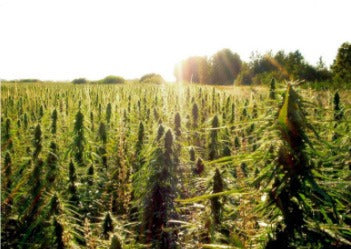What are Trichomes?

Exactly what are trichomes? If you’ve ever taken an up-close look at a cannabis plant, you’ve probably seen the small, crystalline, hair-like structures that cover its leaves and flowers. They’re known as trichomes, and they play an extremely important role in the chemistry of cannabis.
Trichomes are where the magic happens when it comes to cannabis. These little crystalline structures are where cannabis compounds are produced, including the cannabinoids, terpenes and flavonoids that contain the wellness-promoting benefits that gave CBD products their time in the limelight.
If you’re someone who enjoys taking CBD on a regular basis, you’ve got trichomes to thank for it. Through the natural process of biosynthesis, the first cannabinoid to form within trichomes is CBGA (cannabigerolic acid), which is the precursor to all other cannabinoids.
Let’s take a detailed look at trichomes so we can better understand the role they play when it comes to cannabis.
What are Trichomes?

Trichomes aren’t just found in cannabis. The word “trichome” stems from the Greek word tricoma which means “hair.” The official definition of trichomes is “fine outgrowths or appendages on plants, algae, lichen and certain protists.”
Trichomes, when viewed under a microscope, look like hairs with a bulbous tip and somewhat resemble the shape of a mushroom. These resinous glands typically range between 10 and 100 micrometers in width, and they completely cover the flowers and leaves of the budding plant.
Trichomes emerge when the cannabis plant moves into the flowering stage. When cannabis flowers start to bloom, trichomes take shape on the stalks, buds and leaves of the plant.
What is Their Function?
Trichomes are highly diverse and serve a wide range of functions that vary across plant species. The location, size, density and form of trichomes on various plants provide different advantages.
What exactly do trichomes do?
These tiny, resinous hairs can be considered a plant’s first defense mechanism. They deter certain and frost from surface cells, as well as disrupt the flow of air when it’s windy and reflect UV rays.
This defense is especially helpful for cannabis plants which are often victim to insects and animals when grown in the wild. The trichomes help protect cannabis flowers from animals with their pungent smell and bitter taste, and from the wind and strong UV rays that may otherwise cause damage.
Trichomes help to catch prey in carnivorous plants. Take the Venus flytrap, for example. The “trap” consists of two hinged lobes at the end of each leaf. On the inner surface of these lobes are trichomes that make the lobes snap closed on their prey.
Different Types of Trichomes
Stinging hairs, glandular trichomes, and scale or peltate hairs are all examples of different kinds of trichomes. Cannabis contains different types of trichomes which belong to two different categories: glandular and non-glandular. The only type of trichome that produces cannabinoids and other cannabis compounds are glandular trichomes. Trichomes found on cannabis include:
- Bulbous trichomes
Bulbous trichomes are the smallest of the three types of trichomes found on cannabis plants. They only reach a size of 10 to 15 micrometers which makes them nearly invisible to the naked eye and cover the entire cannabis plant.
- Capitate-sessile trichomes
Reaching a size of approximately 25 to 100 micrometers, capitate sessile trichomes are slightly larger than bulbous trichomes. They contain a single-cell stalk and bulbous head and are found in greater abundance in cannabis than bulbous trichomes.
- Capitate-stalked trichomes
Capitate-stalked trichomes are the largest and most abundant trichomes found on the cannabis plant. These trichomes are considered the most important because they’re where the most abundant concentrations of cannabis compounds are found. The stalk of capitate-stalked trichomes is prominent, and the head is significantly bulbous. They’re also the ones that are visible to the naked eye.
How Cannabis Compounds are Created

You may have already heard of the term biosynthesis. Biosynthesis is the process in which complex structures are built out of simple ones. Cannabinoids, terpenes and flavonoids are produced in the trichomes through the process of biosynthesis.
During biosynthesis, there are three basic steps that take place in trichomes to produce these cannabis compounds:
- Binding: When microscopic enzymes bind to one or two small molecules, known as substrates.
- Prenylation: When substrates attach to each other, causing a chemical conversion of the substrates.
- Cyclization: When the transformed substrate is passed to another enzyme, where it is further processed and subsequent changes are made.
The photosynthetic process takes place in the secretory vesicle within the trichome gland head. As the cannabis plant grows, cannabinoids, terpenes and flavonoids accrue along the outer cuticle of the trichome. When the secretory vesicle creates oil, it is pushed toward the cuticle of the trichome head causing it to grow thicker and more bulbous.
We discussed earlier that trichomes appear during the flowering stage of cannabis growth. Trichomes are usually clear or faintly amber at the beginning of this stage of growth. Just before harvest, when cannabinoid, terpene and flavonoid levels reach their peak, the gland head of the trichome will turn opaque or cloudy. At this point cannabinoid levels reach full maturity and generally when plants are harvested for maximum cannabinoid levels.
Trichomes and the Creation of Cannabinoids
CBGA is the first cannabinoid to develop in trichomes. Consider CBGA the foundation on which all other cannabinoids are created. The “A” stands for acid and indicates the presence of a carboxylic acid group, which is also the case for other cannabinoids that end with an “A.” The carboxylic acid group is dropped when heated, a process known as decarboxylation.
CBGA is formed within trichomes through an intricate chain of biosynthesis reactions where geranyl pyrophosphate and olivetolic acid bind to each other. GOT is an enzyme that helps this process.
When geranyl pyrophosphate and olivetolic acid have come together to form CBGA, the complex process of biosynthesis continues. As CBGA goes through the process of cyclization, or the formation of one or more rings in a chemical compound, other cannabinoids begin to take shape in their acidic form.
THCA (tetrahydrocannabinolic acid), CBDA (cannabidiolic acid) or CBCA (cannabichromenic acid) are created with enzymes referred to as THCA synthase, CBDA synthase or CBCA synthase. Which cannabinoid is the most dominant is largely determined by the existence and comparative quantities of specific enzymes.
Trichomes: A Vital Aspect of the Complex Cannabis Plant
It’s safe to say that the majority of us who take CBD on a regular basis don’t think of the complexity that goes into its creation. However, without the presence of trichomes, the many benefits of CBD wouldn’t be possible. We hope you enjoyed learning more about the biological process that occurs within the cannabis plant that forms the basis for its wellness-promoting potential.
Thanks for reading! To show how much we appreciate you, we’re going to give you 16% off your next order. Just use code READER16 at checkout!

Newsletter signup
Join the Joy Organics Family
Sign up and get updates on new products, as well as special coupons and discounts.
testimonials
What Our Clients Say
“This is a company that truly cares about its customers and providing the best CBD products currently available on the market.”










Join In On The Conversation
Your email address will not be published. Required fields are marked *
Comments will be approved before showing up.